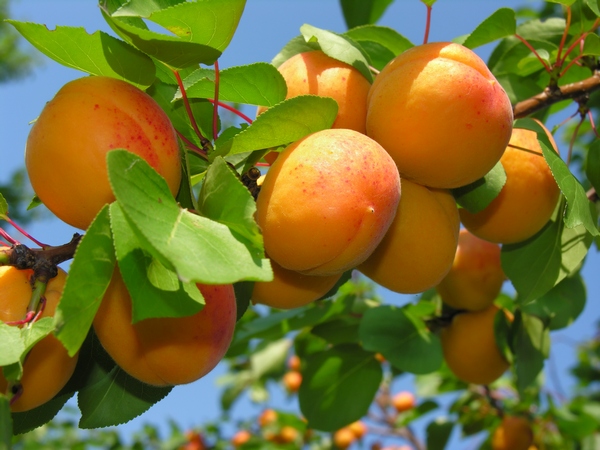 APRICOT
APRICOT
Apricot in our conditions grows in height 4-6 m and forms conical or spherical crowns, pendulous or spreading. The trees have a well-developed root system; the greatest amount of roots is in the depth 20-35 Cm, part of them grows into 60 cm into the ground.
Apricots have thick shoots, naked, greenish to brown-red in color. Apricot leaves are wide ovoid or heart-shaped, the edge of the leaf blade – notched and serrated. The fruit of the apricot is a spherical stone fruit, less often oblong or flattened.
Apricots live much longer than peaches, because, under favorable conditions, even to 80 lat, and mostly with us 20 lat. They start vegetation very early in spring, and they bloom at the earliest of all fruit trees, even before the peach. The flowers appear before leaves develop and are susceptible to frost, which is often the cause of crop loss. Apricots enter the fruiting period in 3-5 one year after planting in a permanent place. They bear fruit abundantly and regularly. The fruits usually ripen at the end of July – at the beginning of August; from one tree you can get to 200 kg of fruit, and even more. Apricot trees are quite frost resistant, because they withstand temperatures down to -30 ° C. Apricots do best in dry and warm climates. They require easily heating soils, for example. sandy and sandy loam. They grow well and yield well in clay soils, but drier. They cannot stand excess moisture in the soil.
The basic varieties of apricots are: Early Orange and Hungarian Early.
Early Orange is an American variety. The tree grows vigorously, forming a conical crown, high, little branched. Leaves have large, Thick, round with short, dark green top. It is easy to distinguish from other varieties on the basis of its characteristic, conical shape. It starts bearing fruit even in the second year after planting. In good conditions it bears fruit abundantly, produces medium-sized fruit, about weight 35-45 g. spherical-oval, flattened from the sides, Regular. The skin is dark orange with bright red, fuzzy blush, covering more than half the surface of the fruit, weakly mossy, strong. Dark orange flesh, strict, fleshy, medium juicy, more and more juicy as it matures, sweet, with a sour aftertaste, aromatic, very tasty. The fruit begins to ripen in the second half of July, not simultaneously.
Hungarian Early comes from Hungary. Medium-sized tree, it forms wide-conical crowns with slightly hanging branches. It enters the fruiting period in 3-4 one year after planting. It produces medium-sized fruit weighing in 45 g, spherical, slightly flattened on the sides, with a slightly concave apex and a shallow furrow near the apex, and deep at the stalk. Orange-yellow peel with a raspberry-red blush, lightly downy. Light flesh, orange-yellow, quite juicy, overripe turns off easily. It stands out very well from the stone. The fruits ripen in late July or early August. It can be propagated by sowing. It is less resistant to frost than Early Orange.
Varieties are recommended as perspective ones: Moorpark and Somo (Mixed Breed No. 86).
The first one is the English variety. The tree grows vigorously and forms a wide crown, wide area, clearly flattened. The leaves are large, wide, round, with a short, sharp tip. It comes to fruiting not too early – usually in the fourth year after planting. The fruit is good for preserves, are of medium size, about weight 30-50 g, spherical or oval, Irregular, usually with one side larger. Yellow-orange skin with a dark purple blush, covering almost half of the surface of the fruit, to the group, strong, very slightly mossy. Dark orange flesh, medium strict, dissolving, juicy, sweet, slightly acidic, spicy, aromatic, very tasty. The fruits usually ripen in early August.
Somo (Mixed Breed No. 86) is a seedling of Somorowski, former employee of the Institute of Pomology in Skierniewice. The tree grows moderately fast, creating a wide conical crown, highly compacted. The leaves are clear, small, about weight 15-25 g, spherical, flattened, often irregular. Dark orange skin with weak, with a dotted blush, slightly downy, medium thickness, strong. Dark orange flesh, medium strict, relatively juicy, sweet, aromatic, quite tasty. The fruits usually ripen in the second half of August.
Taking advantage of this, that many apricots are quite faithful to repeat their characteristics, you can propagate them from seed. The harvested apricot seeds should be stratified, before this treatment, it is recommended to soak apricot seeds for one day.
It must be noted, that apricots grafted on alche are more susceptible to disease and less long-lived than those growing on apricot rootstock.
Apricot diseases and pests
Under our conditions, diseases and pests do not threaten apricots to such an extent, like other fruit trees. Trees can, however, be attacked by the gray rot of stone trees, Thanks to the leafiness and mildew. They are fought similarly, as with plums and peaches. A blueberry scroll, which can be recognized by the sawdust spilling out of the trunk, should be liquidated, spraying the trunk and boughs of the Owado-Moat in the first days of June by Col.. 50 (0,3%).